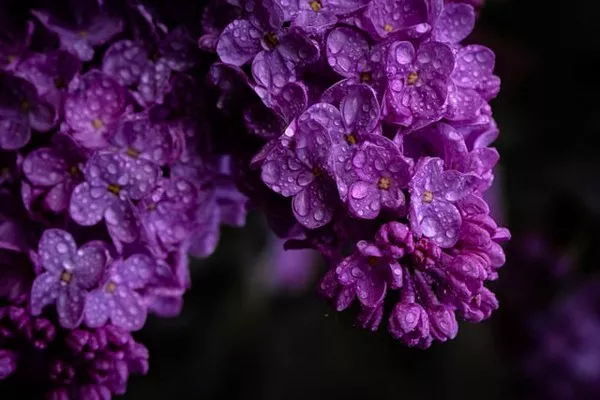Lilac flowers, with their delicate petals and enchanting aroma, have long been a beloved presence in gardens and floral arrangements. These beautiful blooms are not just admired for their ornamental appeal; they have also piqued the curiosity of many, leaving them wondering whether lilac flowers are safe to eat. In this article, we will delve into the world of lilac flowers and explore their culinary potential, highlighting their historical use, nutritional properties, and how to incorporate them into your diet safely.
A Brief History of Lilac Consumption
Lilac flowers, scientifically known as Syringa vulgaris, have a rich history spanning centuries. Native to Southeastern Europe and Asia, the lilac plant has been cultivated for its stunning blossoms since the 16th century, primarily for ornamental purposes. Despite its primarily ornamental role, lilac flowers have had occasional forays into culinary and medicinal realms.
In traditional European herbalism, lilac flowers were utilized for their purported medicinal benefits. They were believed to have diuretic, anti-inflammatory, and astringent properties. These uses, however, were not without controversy and remain largely anecdotal.
Nutritional Profile of Lilac Flowers
Lilac flowers, like many edible flowers, contain a range of nutrients and bioactive compounds that make them appealing to the culinary world. While they are not a significant source of essential nutrients, they do offer certain unique elements.
Phytonutrients: Lilac flowers are rich in phytonutrients, including anthocyanins, flavonols, and tannins. These compounds are known for their antioxidant properties, which may help combat oxidative stress in the body.
Essential Oils: Lilac flowers contain essential oils that contribute to their distinct fragrance. These oils can also provide a delicate flavor when incorporated into culinary preparations.
Vitamins and Minerals: While not a prominent source of vitamins and minerals, lilac flowers do contain modest amounts of vitamins A and C, along with small amounts of minerals such as calcium and potassium.
Safety Considerations
Before you embark on a culinary adventure with lilac flowers, it is essential to be aware of some safety considerations:
Organic and Untreated: Ensure that the lilac flowers you intend to eat are free from pesticides, herbicides, and other chemical treatments. If you’re growing them in your garden, opt for organic practices.
Allergies: Just like any food, some individuals may be allergic to lilac flowers. It is recommended to conduct a small sensitivity test before consuming them in larger quantities. This involves placing a small part of the flower on your tongue and monitoring for any adverse reactions.
Plant Identification: Accurate identification is crucial. Confusing lilac flowers with non-edible plants can lead to unintended health consequences. If you are not entirely sure, seek the guidance of an experienced forager or botanist.
Culinary Uses of Lilac Flowers
Lilac flowers can be used in various culinary applications, adding a touch of elegance and a hint of floral sweetness to your dishes. Here are some creative ways to incorporate them into your cooking:
Lilac Infused Syrup: One of the most popular uses for lilac flowers is in the creation of lilac-infused syrup. To make this delicate syrup, combine sugar, water, and lilac blossoms in a saucepan. Heat gently until the sugar dissolves, and the syrup takes on the lilac’s color and flavor. This syrup can be used to sweeten beverages, drizzle over desserts, or even in cocktails.
Floral Salads: Sprinkle lilac flowers over fresh green salads to add both color and a subtle, fragrant flavor. They pair well with mixed greens and light vinaigrettes.
Lilac Butter: Infuse softened butter with lilac flowers for a unique and fragrant spread. It can be used on toast, scones, or as a finishing touch for grilled vegetables.
Baked Goods: Incorporate lilac flowers into your baked goods, such as muffins, cupcakes, and shortbread cookies. These delicate flowers can be used as a garnish or blended into the batter for a hint of floral sweetness.
Lilac Tea: Infuse dried lilac flowers in hot water to create a soothing and aromatic lilac tea. You can enjoy it as is or use it as a base for other herbal infusions.
Lilac-Infused Honey: For a delightful twist on honey, infuse it with lilac flowers. The honey will take on a subtle lilac flavor, perfect for drizzling over pancakes, waffles, or yogurt.
Floral Ice Cubes: Freeze lilac flowers in ice cubes to add a touch of elegance to your beverages. They make a stunning addition to summer cocktails or simply a glass of sparkling water.
Candied Lilac Petals: Candying lilac flowers is a delightful way to preserve their beauty and flavor. Dip the petals in egg whites, dust with sugar, and allow them to dry. These make for elegant decorations on cakes and desserts.
Lilac Flowers in Cultural Cuisine
While lilac flowers are not staples in modern Western cuisine, they have been used in traditional and regional dishes across the globe:
Chinese Cuisine: Lilac flowers, known as “muge,” have been used in Chinese cuisine for centuries. They are often used in soups, teas, and as a flavoring agent.
Mediterranean Cuisine: In Mediterranean countries like Greece, lilac flowers are used in salads, herbal infusions, and even for making preserves and jellies.
Middle Eastern Cuisine: In some Middle Eastern regions, lilac flowers are used to make a sweet syrup known as “qater” or “atir.” This syrup is used to flavor desserts, beverages, and pastries.
Conclusion
The question of whether you can eat lilac flowers is met with a resounding “yes,” provided that you follow the safety guidelines and take the necessary precautions. These lovely blooms, with their delicate flavor and aromatic charm, can be a delightful addition to your culinary repertoire. Whether used in infusions, baked goods, or salads, lilac flowers bring a touch of elegance and a hint of floral sweetness to your dishes. Just remember to enjoy them in moderation, savoring their unique flavor and fragrance while keeping an eye on potential allergies or adverse reactions. In doing so, you can savor the beauty of lilac flowers not only in your garden but on your plate as well.


